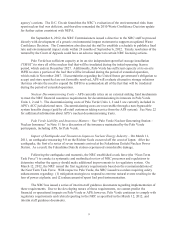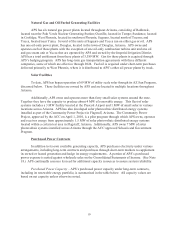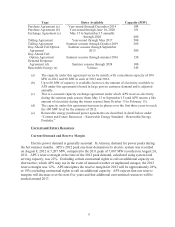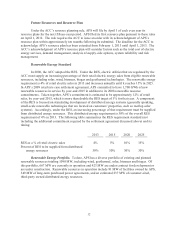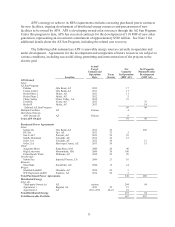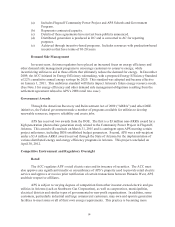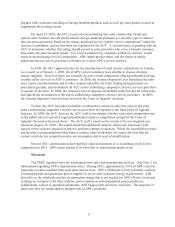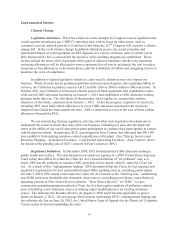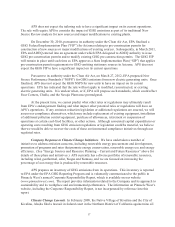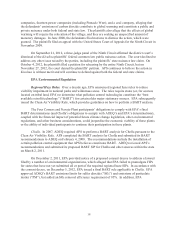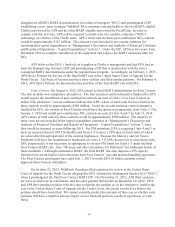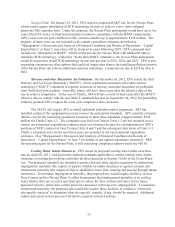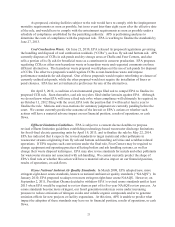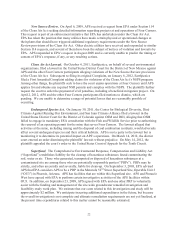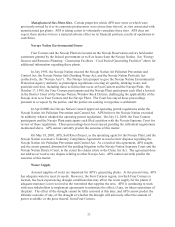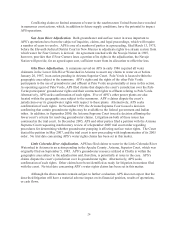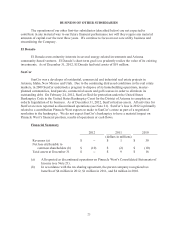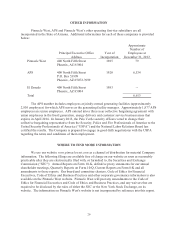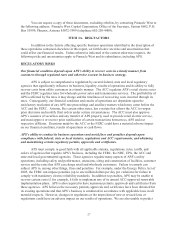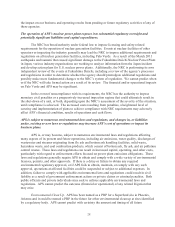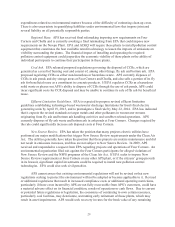APS 2012 Annual Report Download - page 43
Download and view the complete annual report
Please find page 43 of the 2012 APS annual report below. You can navigate through the pages in the report by either clicking on the pages listed below, or by using the keyword search tool below to find specific information within the annual report.19
disapproved ADEQ’s BART determinations for oxides of nitrogen (“NOx”) and promulgated a FIP
establishing a new, more stringent “bubbled” NOx emissions rate applicable to the two BART-eligible
Cholla units owned by APS and the other BART-eligible unit owned by PacifiCorp. In order to
comply with this new rate, APS will be required to install selective catalytic reduction (“SCR”)
technology on all three of the Cholla units. APS’s total costs for these post-combustion NOx controls
would be approximately $187 million. This amount is not included in our current estimates for
environmental capital expenditures in “Management’s Discussion and Analysis of Financial Condition
and Results of Operations – Capital Expenditures” in Item 7. Under the FIP, APS has five years from
December 2012 to complete installation of the equipment and achieve the BART emissions limit for
NOx.
APS believes that EPA’s final rule as it applies to Cholla is unsupported and that EPA had no
basis for disapproving Arizona’s SIP and promulgating a FIP that is inconsistent with the state’s
considered BART determinations under the regional haze program. Accordingly, on February 1, 2013,
APS filed a Petition for Review of the final BART rule in the United States Court of Appeals for the
Ninth Circuit. The State of Arizona and three other utilities also filed similar petitions. On February 4,
2013, APS filed a Petition for Reconsideration and Stay of the final BART rule with EPA.
Four Corners. On August 6, 2012, EPA issued its final BART determination for Four Corners.
The rule includes two compliance alternatives. The first emission control alternative finalized by EPA
would require the installation of post-combustion controls on each of Units 1-5 at Four Corners to
reduce NOx emissions. Current estimates indicate that APS’s share of total costs for Four Corners for
these controls would be approximately $400 million. Under the second emission control alternative
finalized by EPA, the owners of Four Corners would have the option to permanently close Units 1-3 by
January 1, 2014 and install post-combustion NOx controls on each of Units 4 and 5 by July 31, 2018.
APS’s share of total costs for these controls would be approximately $300 million. The majority of
these costs are not included in the capital expenditure estimates in “Management’s Discussion and
Analysis of Financial Condition and Results of Operations – Capital Expenditures” in Item 7, since
they would be incurred in years following 2015. For PM emissions, EPA is requiring Units 4 and 5 to
meet an emission limit of 0.015 lb/mmBtu and Units 1-5 to meet a 20% opacity limit, both of which
are achievable through operation of the existing baghouses. Because the Mercury and Air Toxics
Standards will force the installation of baghouses on Units 1-3 if APS chooses not to close those units,
EPA determined it is not necessary or appropriate to set new PM limits for Units 1-3 under the final
Four Corners BART rule. (See “Mercury and other Hazardous Air Pollutants” for additional details of
these standards.) Although unrelated to BART, the final BART rule also imposes a 20% opacity
limitation on certain fugitive dust emissions from Four Corners’ coal and material handling operations.
The Four Corners participants have until July 1, 2013 to notify EPA of which emission control
approach Four Corners will follow.
On October 22, 2012, WildEarth Guardians filed a petition for review in the United States
Court of Appeals for the Ninth Circuit alleging that EPA violated the Endangered Species Act (“ESA”)
when it promulgated the final Four Corners BART FIP. On November 21, 2012, APS filed a motion
for leave to intervene as a defendant, and the court granted that motion on December 10, 2012. EPA
and APS have pending motions with the court to dismiss the petition or, in the alternative, transfer the
case to the United States Court of Appeals for the Tenth Circuit, the circuit in which we believe the
petition should have been filed. We cannot currently predict the outcome of this case or whether such
outcome will have a material adverse impact on our financial position, results of operations, or cash
flows.


